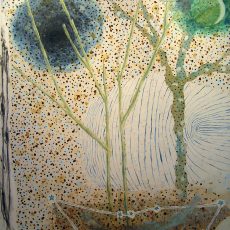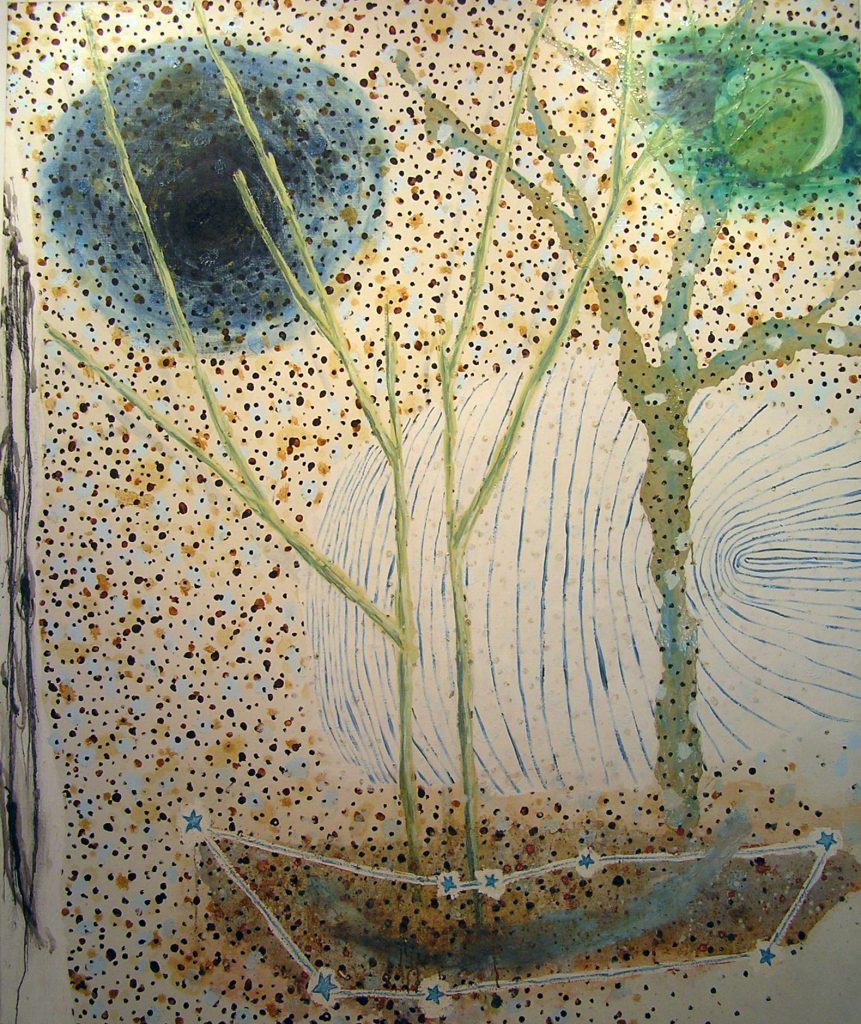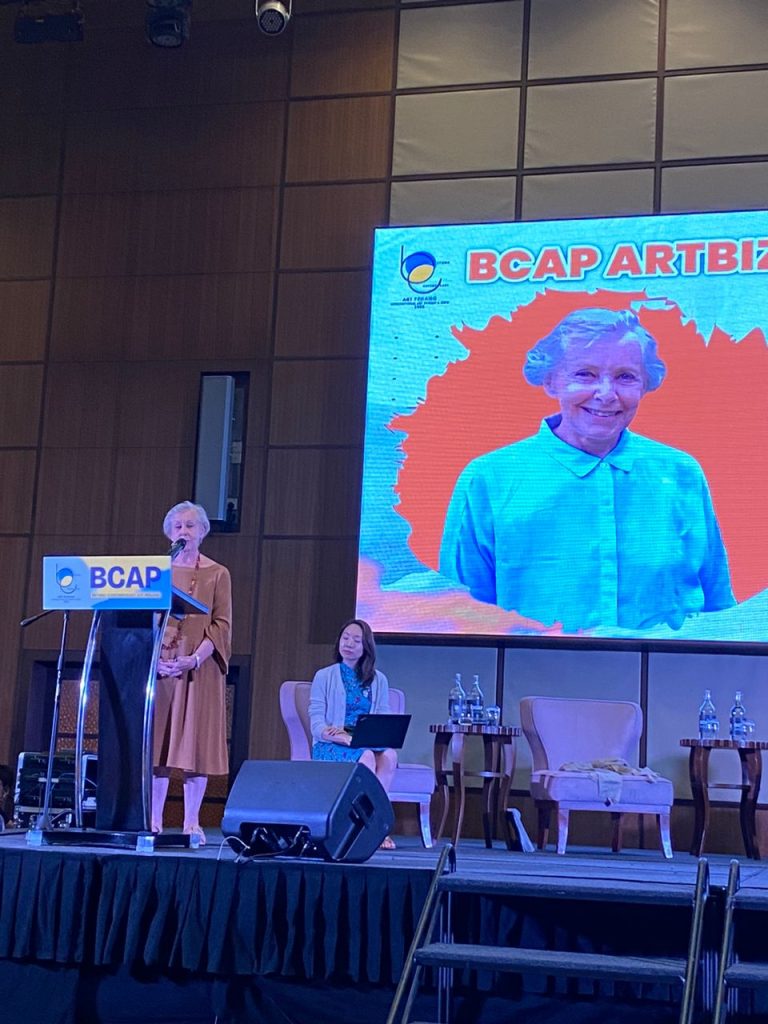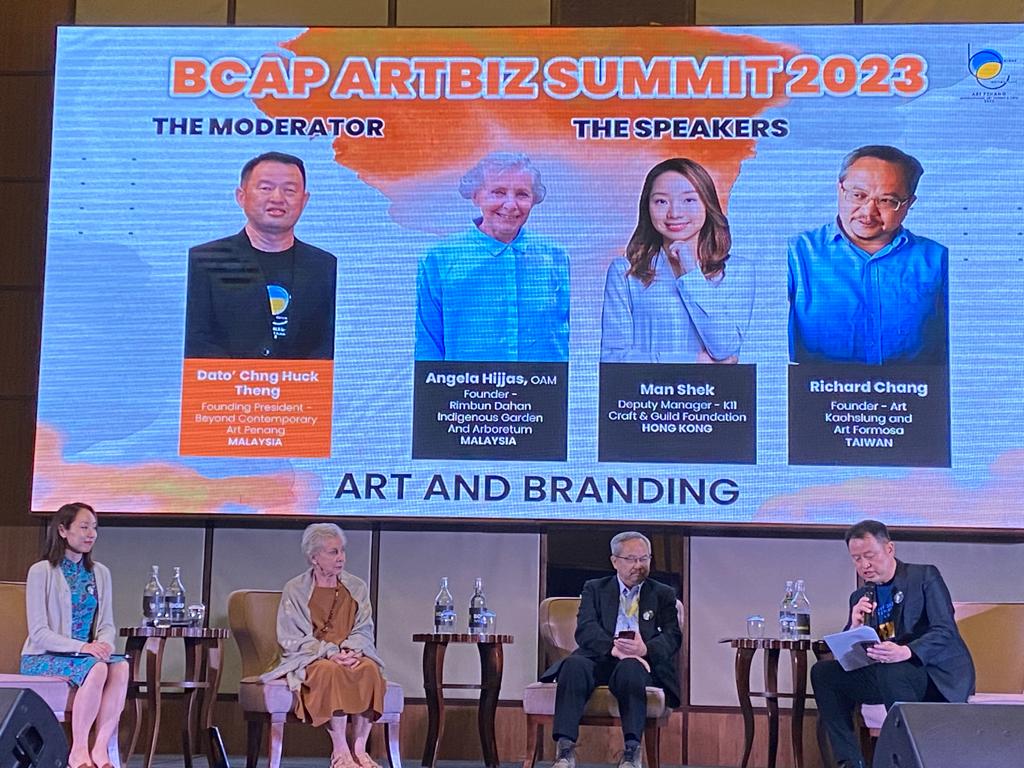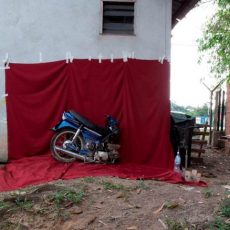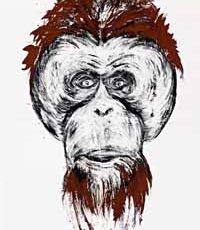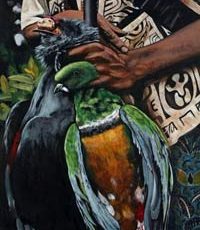by Angela Hijjas
A speech published in the catalogue of Beyond Contemporary Art Penang (BCAP), November 2023, in George Town, Penang.
When my husband Hijjas and I started a residency programme for artists in 1994, I had little idea what the creative process for visual artists was like. The first Australian artist who took up the 12-month residency at Rimbun Dahan was John Foubister, from Adelaide. He was thoughtful and wanted to explore his ideas by using others as his sounding board. We talked often about the ‘problems’ he had to ‘solve’ with his paintings, and he often referred to other artists who had used this or that process or solution. Not being an artist myself, I never understood exactly how he resolved the problems presented by his paintings, but certainly discussion was part of the solution. I was happy to learn about artistic practice from him, and I believe he painted some amazing works.
John Foubister’s paintings were challenging for the general public, especially in the context of his joint exhibition alongside Yuande Zheng, the Malaysian artist who was also undertaking the residency, and whose work was figurative, realistic and less unusual. Yuande’s work sold well at the exhibition, but not so John’s; for many viewers, his works struck a discordant note.
John continued to hone his artistic craft, while living on his earnings as a carer for people with disabilities. Now, 30 years later, he can make a living from his artistic practice, even if modestly, and he is recognised in Adelaide as an original thinker and a creator of beautiful paintings inspired by the South Australian landscape.
But John Foubister will never be a brand. His work is never the same; it is always changing. There are always new problems he is interested to solve with paint, and new ways that he discovers of solving them. The entire point of his artistic practice is to work at this continual art of discovery, not to pander to the art market by constantly reproducing easily legible, easily sellable copies.
My experience in the art world is not one from the perspective of commercial galleries, dealers, and auction houses, with their skyrocketing prices, and their view of art as a financial investment or a luxury collectible. Our residency at Rimbun Dahan is devoted to helping artists develop their careers by giving them the time and space to focus on their artistic practices, and then share the products of that creative period with the public.
Initially, we supported one Malaysian and one Australian artist for one year, leading to a joint exhibition. Currently we no longer offer the Australian residency, but invite artists from the ASEAN region and Malaysia instead, for shorter residencies between one and three months, concluding with informal open studio days rather than full-scale exhibitions. [Australia offers many opportunities for artists, but there are very few throughout the ASEAN region, and I feel we have more impact on not just art but also on international goodwill by developing links between our immediate neighbouring countries, through strong personal relationships forged during our residencies by artists staying in the same community and working alongside each other.]
Over three decades of leading this residency, I have learned how much artists need this kind of support: the opportunity to focus on their work alone, with less pressure from the need for, and the demands of, a day job. There is very little support available in Malaysia to give artists a boost early in their careers, and although our program is small it does provide help to some. Exhibitions – having a finished product available for sale – are not the intended result of this creative residency process. The open-ended residency, without a focus on product, allows the artist to engage deeply with the time-consuming and often difficult task of developing new work from new ideas. If artists were to merely rework the same ideas over and over, they would become bored, and viewers and collectors would find their work lacking in vigour and development.
Thus the concept of art and branding together is to me rather an alien combination. I understand branding as something that is wholly commercial, with the intention to sell a product. Branding is fixing a stamp or a style – often visual – that is readily recognised by the general public, and that guarantees a kind of consistency of experience by the consumer. The brand is coveted and protected, perhaps tweaked for different markets, but otherwise carefully and conservatively deployed by marketing teams, until the brand itself becomes desirable, something that people want to buy and be associated with, merely by choosing a product.
To me, art is much too diverse, too liable to take off in new and unrecognisable directions by leaps and bounds, to be suitable for branding. Yes, you can recruit artists to help create visuals that are incorporated into a product or brand, but this is more strictly the realm of graphic design or industrial design – of commercial art, not fine art. Here, the artist is trained to take a brief from a client, be it a tobacco corporation or a perfume house, and to develop images that favourably portray the product, possibly including a simplified image that is striking and memorable: the logo.
Many artists do work in this commercial environment, as it is an area where their skills are useful – but that can only be their “day job”, which allows an artist to survive and feed his or her family. By contrast, the “night job” for an artist is exploring what he or she can do with certain materials that they find compelling, to make what they have been thinking about in every spare moment. It is not a process that can be hurried, and the final result cannot be predicted. That is why generally it takes artists several years to reach a point where their work is ready for a show.
Some artists, though, have inadvertently embraced branding. The Malaysian painter Ibrahim Hussein enjoyed amazing commercial success over his entire career, from the 1960s to his death in 2009. He had a superb sense of colour and form that resulted in beautiful works, and he pushed his boundaries, until he discovered his distinctive and recognisable lines. These works flew off the easels to collectors, who knew that these works were keepers.
Ib kept doing them through his last years, but it was clear the inquiry stage of his process was over – he had his answer. While he continued to produce wonderful works, the later works had a sameness that is similar to branding. Gone were the experiments like photo montage that he had invented and developed, and the urge to comment on social and political issues that he had pioneered in his younger years. [Few will remember his Palestinian series in the 1970s, for which he asked me to write the catalogue notes to verbalise his outrage, just in case anyone missed the point – which was hardly likely!] I’m not saying that his style was any less wonderful, but, like most of us, Ib lost the urge to explore as he got older. As we know, change is challenging, but it leads to our growth and enrichment.
In contrast to Ibrahim Hussein, I would like to mention another artist here: Penang’s own Latiff Mohidin, who actually got his start in Singapore where he attended Kota Raja Malay School with my husband Hijjas. [As youngsters, both of them sold their paintings on the street to the likes of the late Ungku Aziz – thank God for patrons!] Latiff has explored new ideas all his life; in his painting and sculpture he drew on everything he saw in his travels throughout Southeast Asia, and painted forms that cried out to be sculptures. He honed that delicate boundary for his whole life and continues to do so in his eighties.
But Latiff is not a brand, nor, I suspect, would he want to be. His initial success depended on his Pago Pago series in the 1960s, but he diverged time and again to develop new ideas. I remember the shock of his Mindscape series in the 70s and 80s – what was he doing, people wondered, and why? The answers the public was looking for did not really matter; Latiff had an insatiable desire to explore and renew. To me, that is a mark of a good artist, and Latiff’s practice is something for younger artists to emulate.
I feel all fine artists would devalue their talent and potential by even thinking about branding their work. Here, as another example, I want to discuss a more contemporary artist, this time a woman: Nadiah Bamadhaj. Her practice, too, defies the concept of branding, although she is on the A list of all serious collectors of contemporary Southeast Asian art. While her work now fetches high prices and many galleries would like her as part of their ‘stable’ of artists, she has defied the establishment galleries to forge her own path.
Nadiah studied fine arts in New Zealand where she majored in sculpture. Given the high prices of materials and the scarcity of commissions, becoming a successful sculptor is notoriously tricky. But Nadiah was nothing if not persistent and persuasive. The artworks were all in her head; she just had to make them happen. In 2001, she persuaded Galeri Petronas to give her a solo exhibition called “1965: Rebuilding its Monuments”, but she needed a studio and time to develop the work. Fortunately for us, she asked Rimbun Dahan for help.
I cannot say I was overjoyed by someone turning up at my door demanding a residency, but she reminded me of my own daughters, so I agreed to provide a studio and a place to stay for 6 months leading up to the exhibition, and a measly allowance of RM500 a month to live on. Nadiah had decided she had had enough of working for other people; she had to strike out on her own. She worked day and night to realise her vision for the exhibition, which ended up launching her career. I was fortunate enough to acquire some works from the show, so I was royally rewarded. And now with full confidence in her own work, Nadiah can explore her skills and talents as an independent artist without the imposed direction of galleries.
None of Nadiah’s planning, I believe, involved constructing a brand, but she has developed herself as a formidable artist and made an indelible contribution to our contemporary culture. In “1965 – Rebuilding its Monuments”, she tackled the history of this region and its terrifying cost: how politicians manipulate the public to line their own cosy nests. Her themes were based on Indonesia’s experience, but they apply to all of us, and this is the kind of cultural development that Hijjas and I have been striving to support: looking at who we are, where we come from, and what we hope to be. Nadiah presented her ideas in an art form which realised the full power of the graven image. And now, 22 years later, thanks to her newfound financial security from the sale of her celebrated artworks, Nadiah is producing the sculptures that she dreamed of when first starting her career.
From my decades of living in proximity with working artists, who are serious about developing their professions by pursuing their own curiosity, I would say that artists are not particularly interested in branding. But I have also learned that the opinions of artists should not be taken for granted. They should be consulted about matters that relate to them and their practices. Too often arts policy schemes are implemented without any discussion with the people who will be most affected, resulting in valuable resources being channelled in the wrong direction and eventual policy failure. Consultation is critical; the first principle must be to ask artists what they need.
I have witnessed many ill-conceived ideas that purport to help artists, but end up taking advantage of them. For example, artists are invited to contribute work for free to charity exhibitions, in exchange for nebulous ‘exposure’. Or artists are offered personal loans which they are expected to pay back after a sell-out exhibition, encouraging artists to create safe sellable work rather than challenging their own boundaries. Most public arts grants are offered for performing artists or literature, with fine art left on the sidelines. Perhaps this is because some visual artists, like Nadiah Bamadhaj, do indeed succeed in supporting themselves by their artistic work, which is a dream for most performing artists. But the vast majority of arts students in Malaysia never attain a viable career. Our public universities are churning out fine arts graduates in every state, and yet the only sustainable career option for these graduates’ futures is teaching – a circular model that doesn’t lead to a thriving arts community.
A real problem in Malaysia is lumping arts with tourism – basically using the arts as picturesque advertising or colourful entertainment intended for foreigners. Sharing our culture with visitors is of course important, but it misses the point. Malaysian art is intended to enrich the lives of Malaysians, both as consumers and creators. Everyone should have access to creative practice, whether it’s playing in a drumming group or writing poetry. There must be a broader choice of cultural pursuits in schools, universities and communities that can enliven the spirits of people who otherwise spend their lives commuting to and fro, studying, working, trying to sustain their lives. We should try to make a rich cultural life a possibility for everyone.
This is where I would like to see the arts develop: ask artists what kind of support they need. Find out what young people want, because they are our future and they are the ones who need the cultural support to develop their many talents and lead fulfilling lives. Celebrate the marvellous things that Malaysian artists have already achieved, through their own hard work and strategies, often scraping and starving to share what they love with as many people as possible.
Rather than viewing the arts as just another industry designed to generate GDP, government and municipalities should shift their paradigms to view the arts as a social good, which we have a collective responsibility to understand and support.

